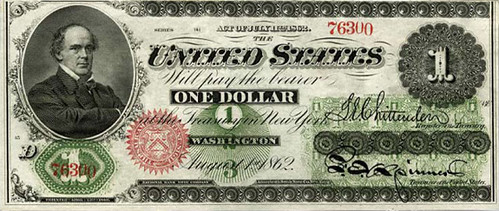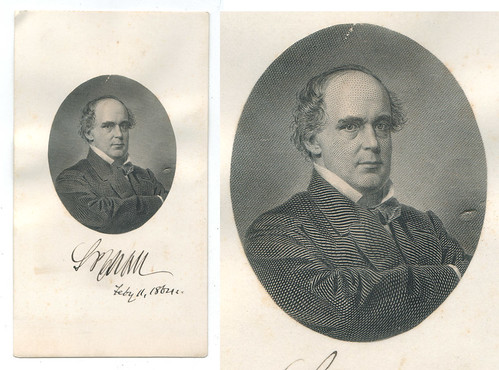
PREV ARTICLE
NEXT ARTICLE
FULL ISSUE
PREV FULL ISSUE
MORE ON SALMON P. CHASE AND HIS ONE DOLLAR GREENBACK
Web site visitor Bruce Baryla forwarded the following comments on the topic of U.S. Treasury Secretary Salmon P. Chase. Thanks!
-Editor

I came across your piece regarding Salmon Chase and the placement of his own portrait on the $1 bill, which references the pamphlet, "Going Home to Vote". Although it is likely that the pertinent passage from this pamphlet is likely already known to you by this time, I thought I would provide it just in case:
"The next question was, "Will you borrow the paper of the banks and give six per cent interest for it, and then pay that to the soldiers in place of gold?" Don't you think that after awhile something would have happened if I had done this? Have you not heard somewhat of revulsions and panics and crashes? Well, what would you have me do? Would you not have said to me: "here am I, Smith, a farmer; here am I, Jones, a mechanic; here am I, Robinson, a merchant. Take our property and our credit and us, and make a currency for the country based on the country itself. In other words, go to work and make 'greenbacks.'" I know that is what you would have advised me to do; and therefore, as my business was to interpret your will -- to know what you would have me do, and then do it -- I went to work and made "greenbacks," and a good many of them. I had some handsome pictures put on them; and as I like to be among the people, and was kept too close to visit them in any other way, and as the engravers thought me rather good looking, I told them they might put me on the end of the one-dollar bills. [cheers and laughter]" It seems to me that the speech passage certainly demonstrates Chase putting the fame generated by his portrait to advantageous political purpose, and his statement all but admits that he dictated the placement of his portrait on the $1 bill. I would think that internal government records would clarify the exact process by which the portrait/denomination decisions were arrived at, but think that even if these confirm that he dictated it there is not likely to be any clue that would constitute a smoking gun to confirm that he had more widespread distribution of his own portrait vs that of Lincoln's in mind. There was a second quote in the "Going Home to Vote" pamphlet that records Chase mentioning his likeness on the $1 bill in another speech:
"As the speaker was retiring amid loud applause, the crowd began calling cheers for "the father of all the greenbacks." Turning again for an instant, he said, "Gentlemen, if you insist on calling me the father of all the greenbacks, you must at least admit that the children, respectable as well as numerous, bear -- a good many of them at least -- quite fair paternal likenesses. I am happy to find that they are well liked and cordially received wherever they go." (Laughter and prolonged applause)" Chase and his daughter certainly actively promoted him by providing photographs and autographs to inquiries for such, as noted in this passage from a biography of Kate Chase:
"Kate was well aware that a good many women wrote to her father for his autograph for their albums, or else for his portrait. It was a current fad to which even Abraham Lincoln had been known to respond. Chase was always trying new photographers. Kate made a careful study of the results and helped to distribute the portraits where they would be most useful. He was undeniably one of the handsomest men on the national scene and was always gallant to women, however unresponsive to his colleagues." I also recall reading of his leaving a torn $1 bill as a calling card for a woman he was pursuing, when she was not present at a hotel at the time he had hoped to meet her. I recently discovered an autographed Chase calling card that features the National Bank Note Company engraving of the $1 bill vignette, trimmed to its oval border and mounted onto manila-weight card stock. The precision with which the vignette was trimmed strongly suggests that it was not a home-made production, but rather that it had been produced by a skilled Treasury Department worker. Also of interest is that the date, February 11, 1864, lies at the precise watershed of Chase's presidential ambitions. The first of the two privately mailed anti-Lincoln pamphlets that destroyed his campaign first appeared in a newspaper the day before, and it would only be a few weeks before Chase was forced to withdraw from contention due to the firestorm the pamphlets had created.

You may see a picture of this item here: ttp://web.newsguy.com/bruceb/chase/chasecallingcard.jpg I am not sure how much use Chase made of this National Bank Note Company engraving for self-promotion but it would be interesting to find out. I would expect that Chase-signed examples of it are not particularly common. I came across your e-zine in the course of researching the calling card with the NBNC proof vignette and would like being placed on your mailing list. Thank you. Perhaps some of your readers will help me clarify the fine points of this proof, and Chase's "purloining" of it for his own use -- or was it official government business use? He was Secretary of the Treasury at the time.
Welcome aboard, and thanks for the great information on Chase. Thoughts, readers?
-Editor
To read the earlier E-Sylum article, see:
MORE ON SALMON P. CHASE AND ABRAHAM LINCOLN
(http://www.coinbooks.org/esylum_v11n21a15.html)
The Numismatic Bibliomania Society is a non-profit organization promoting numismatic literature. See our web site at coinbooks.org. To submit items for publication in The E-Sylum, write to the Editor at this address: whomren@gmail.com To subscribe go to: https://my.binhost.com/lists/listinfo/esylum All Rights Reserved. NBS Home Page Contact the NBS webmaster 
|